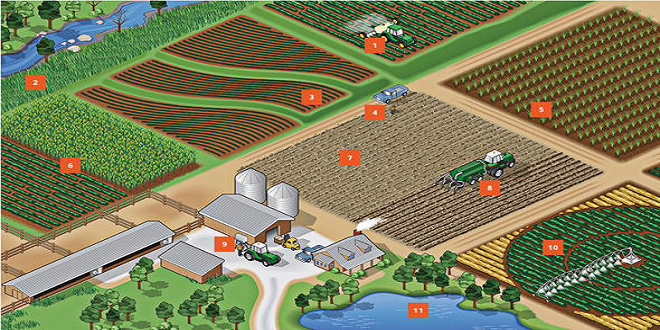Practices for sustainable agriculture

These strategies are part of sustainable primary production:
– Adopting Agroforestry Practices (a land management strategy that combines crops with livestock farming and trees) to increase biodiversity and capture carbon dioxide.
Crop rotation: Less fertilizer is needed and less pollution is produced
– Accepting diversity in crop varieties (improves soil quality, reduces emissions).
– Reduce or eliminate tillage. Tillage can damage soil structure, accelerate decomposition, lose organic matter, and increase erosion risk. It can also destroy the habitat for useful organisms.
– Integrating pest management to minimize the environmental impact
Sustainable food sourcing
Consumers want to know whether food ingredients are locally grown (farm to table), organic, fair trade or made using sustainable farming practices. These practices can help improve brand perception and the environment.
Rethinking distribution
One-third of all food globally is thrown away, which is quite shocking. This is due to poor quality crops being thrown out, suboptimal fruit and vegetable quality being thrown away before they reach shelves, and food that has suffered from transportation. Food manufacturing companies can use strategies like reducing food miles (minimizing distribution distance), which reduces potential food waste and fuel emissions and reusing food wastage (either by themselves or as part of a partnership).
Packaging that is environmentally friendly
Today’s environmentally-conscious consumers are pushing for a shift away from single-use plastic packaging in food manufacturing to more sustainable options. Many consumers expect food manufacturers to reduce their carbon footprint through the use of sustainable packaging options like plant-based packaging (e.g. bamboo, cotton, hemp, wood pulp, corrugated card, and dissolvable packaging like corn starch filler peanuts. It is important to ensure there are no hidden environmental effects. For example, switching from cardboard packaging does not help deforestation. Plus, cardboard production requires a lot of water, so it may not be as environmentally friendly as you think. You can eat both the food and the packaging, but hygiene concerns may arise. For example, you could use edible packaging to make a coffee cup you then drink from. Many food manufacturers have moved away from plastic shrinkwrap in favor of sugarcane polyolefin shrinkwrap, which is both safe for food and biodegradable.
Shrinkwrap machines for food products
Shrinkwrap is widely used in the food industry because of its durability, protection, visibility, or around cucumbers, punnets or other tinned foods. Shrinkwrap machinery is able to significantly reduce production volume and reduce packaging waste. Shrinkwrap machines are capable of working with both the plastic shrinkwrap as well as the new, sustainable shrink films.
Refillable stores
Many shops that are zero waste now offer customers the opportunity to bring back reusable bags and jars to refill large disposable containers. These can hold everything from coffee beans, raisins, organic vegetables, and lentils. This eliminates the need to use disposable packaging. You just need weigh the container before filling it. Payment is based on product weight so you can buy exactly what you need.
Encourage consumers to reduce food waste, and eat sustainably and encourage them to do so
A third of the food bought in households is thrown away. People don’t realize that discarding waste can contribute to climate change. Recycling waste lorries produce fuel emissions, and waste ends up in landfills where it rots, producing methane gas. This pollutes the environment and poses a threat to human health. Landfills can physically damage wildlife habitats and lead to toxins entering water supplies as well as the food chain. In order to reduce food waste, it is essential that we are more aware of the effects of post-consumer trash.
To reduce food waste, consumers can be encouraged make small lifestyle changes.
– Mindful shopping and meal planning
– Optimising storage temperature
Use leftovers for home cooking, take-out and restaurant meals
You can encourage consumers to adopt a sustainable diet by making it vegetarian or vegan, increasing the number of meat-free days, purchasing only seasonal produce or making conscious efforts to purchase food that is sustainably sourced.
Weather conditions, such as rainfall, temperature, and sunlight, directly impact agricultural activities. Farmers rely on favorable weather patterns for crop growth, while extreme weather events like droughts or floods can have devastating effects on crops.




